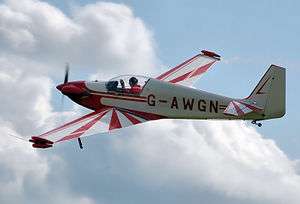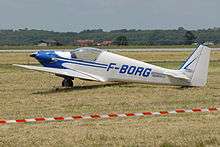Fournier RF-4
The Fournier RF-4 is a single-seater motor glider designed by René Fournier in 1966. It is an aerobatic version of the Fournier RF-3.[1][2]
| RF-4 | |
|---|---|
 | |
| RF-4D | |
| Role | motor glider |
| National origin | France |
| Manufacturer | Alpavia / Sportavia-Pützer |
| Designer | René Fournier |
| Introduction | 1966 |
| Number built | 159[1] |
| Developed from | Fournier RF-3 |
Design and development
Conceived as a motor glider and sport touring aircraft, the RF-4 was introduced in 1966. It is of all-wood construction and is fully aerobatic. The landing gear consists of a monowheel gear which retracts forward into a fibreglass cowling. The main wheel has a brake which is manually operated. There is a small steerable tailwheel and wing-mounted outrigger wheels.[3]
Operational history
An RF-4D was flown by Mira Slovak across the Atlantic Ocean while participating in the May 1969 Daily Mail Air Race. The flight won a £1,000 prize offered by the London Evening News for the best performance in the race by an aircraft under 5,000 lb (2,268 kg) gross take-off weight.[3] The main landing gear fork is an ongoing maintenance issue, with regular replacements needed.[4]
Variants
- RF-4
- Prototype aerobatic variant of the RF-3, three-built by Alpavia
- RF-4D
- Production variant, 155 built in Germany by Sportavia-Putzer, D was for Deutschland. 16 shipped to America[5]
Specifications (RF-4D)

Data from In the Air:Number 230:Fournier RF-4D and Plane and Pilot[3][6]
General characteristics
- Crew: 1
- Length: 6.05 m (19 ft 10 in)
- Wingspan: 11.28 m (37 ft 0 in)
- Height: 1.57 m (5 ft 2 in)
- Wing area: 11.3 m2 (122 sq ft)
- Aspect ratio: 11.2
- Empty weight: 270 kg (595 lb)
- Gross weight: 390 kg (860 lb)
- Fuel capacity: 38 litres (8.4 imp gal; 10 US gal)
- Powerplant: 1 × Rectimo 4 AR 1200 (VW) air-cooled flat-four piston engine, 29 kW (39 hp)
- Propellers: 2-bladed Hoffmann, 1.50 m (4 ft 11 in) diameter
Performance
- Maximum speed: 196 km/h (122 mph, 106 kn)
- Cruise speed: 180 km/h (110 mph, 96 kn)
- Stall speed: 74 km/h (46 mph, 40 kn)
- Never exceed speed: 249 km/h (155 mph, 135 kn)
- Range: 640 km (400 mi, 350 nmi)
- Endurance: 4
- Service ceiling: 5,800 m (19,000 ft)
- g limits: 11
- Maximum glide ratio: 20:1
- Rate of climb: 3.5 m/s (690 ft/min)
- Wing loading: 34.5 kg/m2 (7.1 lb/sq ft)
See also
References
| Wikimedia Commons has media related to Fournier RF-4. |
- pilotfriend.com: Fournier aircraft history, performance and specifications - accessed 13 March 2008
- Sailplane Directory: Fournier RF 5 Archived 2015-11-12 at the Wayback Machine - accessed 13 March 2008
- Plane and Pilot: 1978 Aircraft Directory, page 73. Werner & Werner Corp, Santa Monica CA, 1977. ISBN 0-918312-00-0
- Jack Lambie (October 1979). "Cross Country in a Fournier Motor Glider". Air Progress: 50.
- Dann PArks (July 2014). "Switching to Glide". Sport Aviation: 96.
- Harrison 1968, pp. 669–670.
- Harrison, Neil. "In the Air:Number 230:Fournier RF-4D". Flight International, 2 May 1968. pp. 669–670.